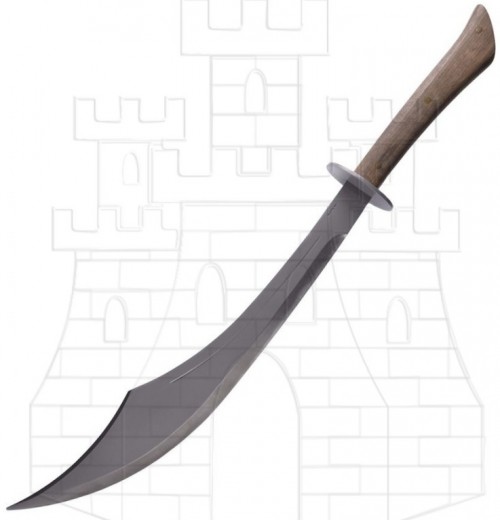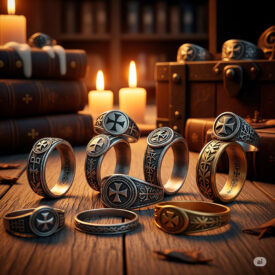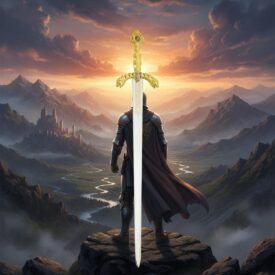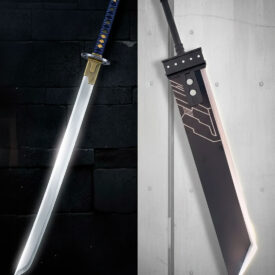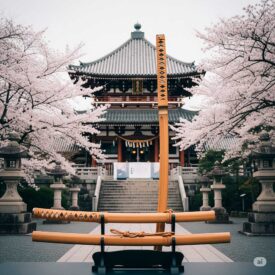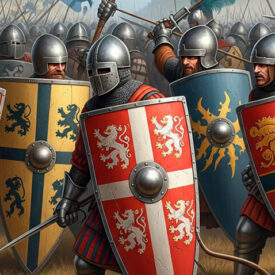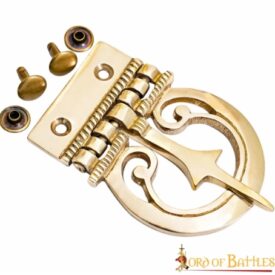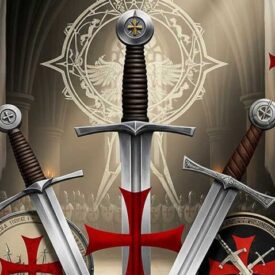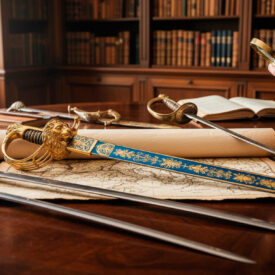The scimitar sword is one of the most recognizable images of the Islamic and Eastern world: a curved, light and sharp blade that not only transformed horseback combat but also left a deep mark on the culture, symbolism and forging art of various civilizations. In this panoramic article you will learn its origin, evolution, regional variants, technical design, use in battle, its symbology and how to recognize replicas and historical pieces.
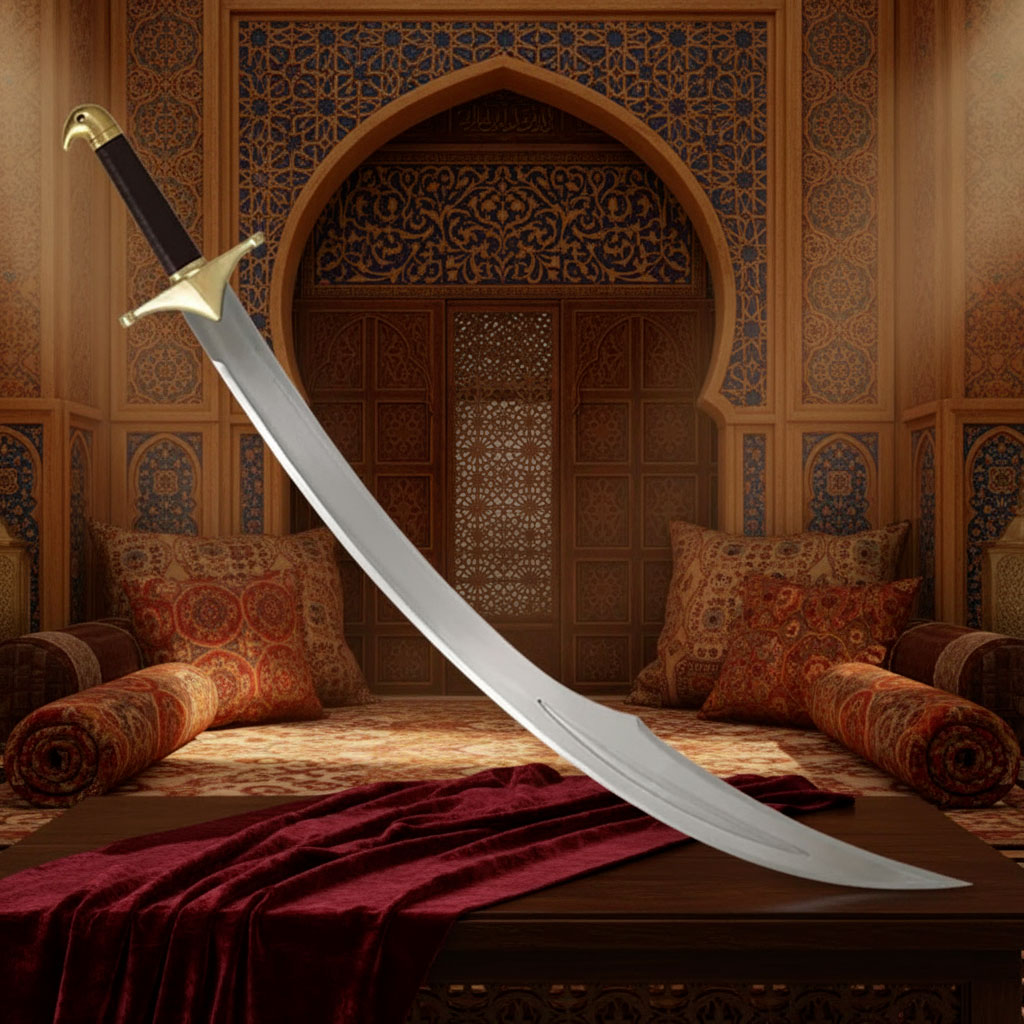
Why did the curved shape mark a revolution in weapons?
The curve of the scimitar is not decorative: it responds to a tactical need. In mounted combat, the inertia of the horse and the trajectory of the rider require a blade that cuts cleanly without getting stuck. The scimitar allows long and continuous cuts, using the speed of movement to maximize the slashing power. This principle is repeated in all its variants, from the Persian shamshir to the Ottoman kilij and the Indian talwar.
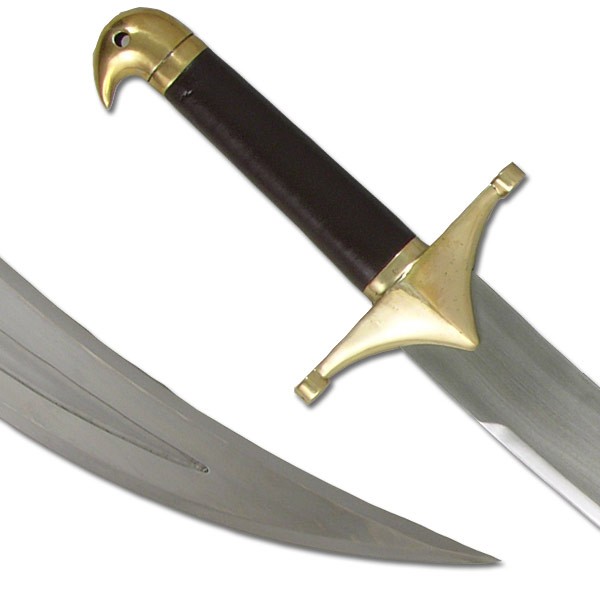
Origin and evolution: from Persia to the entire Islamic world
Although the word “scimitar” is Western (from the Italian scimitarra) and has roots in the Persian shamshir, the design was shaped over centuries. The first influences come from the Eurasian steppe, where Turkic and Mongol tribes used curved sabers for mounted warfare. Already from the ninth century, a very curved sword style was documented in Persia that was perfected by blacksmiths and horsemen.
During the eighth to thirteenth centuries, with the expansion of the Abbasid Caliphate and cultural exchange, the scimitar spread throughout the Middle East, North Africa, and India. In each territory, their own adaptations emerged that responded to local tactics, materials, and tastes.
Synthetic chronology
- Bronze Age: First precursors of curved swords in Mesopotamia.
- 7th Century: Influences from Turkic-Mongol sabers and Chinese dao.
- 8th–13th Centuries: Diffusion during the Abbasid Caliphate; refinement in Persia.
- 12th–15th Centuries: Popularization in the military machinery of the Islamic world; appearance of variants such as the kilij.
- Present Day: Conservation in museums and recreation by modern artisans.
Scimitar Chronology
Brief historical overview of the appearance, dissemination, and cultural legacy of the scimitar from its origins to the present day.
| Period / Date | Brief Description |
|---|---|
| Bronze Age (Ancient Origins) | First known examples of curved swords in Mesopotamia, precursors of the scimitar. |
| 7th Century | Appearance of the Turkic-Mongol saber, possible influence of Chinese dao swords on the scimitar design. |
| 8th–13th Centuries (Abbasid Caliphate) | Curved swords spread widely throughout the Middle East and North Africa. |
| 9th Century (Appearance in the Middle East) | The scimitar (shamshir in Persian) emerges; its design is perfected in Persia with Turkic and Mongol influences; documented use by Persians, Ottomans, and Indians. |
| Middle Ages (Greater Diffusion and Symbolism) | The scimitar becomes the characteristic weapon of the medieval Arab world; associated with the Crusades and loaded with religious and cultural symbolism; recurved swords begin to be known in the West. |
| 12th Century (second half) | Saladin leads the wars for the Holy Land; 1187 victory in Hattin and capture of Jerusalem; the Christian response includes the Third Crusade with figures like Richard the Lionheart. |
| 13th Century | Byzantine iconography depicts curved sabers (paramerion); the first sabers appear in Eastern Europe; in the Iberian Peninsula, straight and wide swords predominate in Almohad/Andalusian contexts. |
| 14th Century | Straight protojineta swords are documented in Gibraltar; recurved swords are already known in the West. |
| 15th Century | The Turkish kilij, a variant of the scimitar, gains great popularity in the Ottoman Empire and is associated with the military elite (Janissaries); possible origin in this century. |
| Early 16th Century (1514) | The term “scimitar” appears in Spanish texts (e.g., Lisuarte de Grecia and Polindo), linked to the Muslim and Ottoman imaginary. |
| 16th Century (Use in the Iberian Peninsula and the East) | Widespread use in the East and Maghreb; probable employment by Barbary corsairs, Ottomans, and Moriscos in Spain; 1568–1571 the Moriscos probably used scimitars in the War of the Alpujarras. |
| After the 18th Century | European sabers replace many double-edged swords in Europe due to their ease of use and less reliance on heavy armor. |
| Present Day | Historical examples in museums (Victoria & Albert, Topkapi, MET, British Museum, Louvre, National Museum of Iran, etc.). The scimitar remains a cultural symbol and source of national pride; modern artisans make it, and it is popular among reenactors, historical fencing enthusiasts, and inspirational in video games. |
Regional variants: how to recognize a scimitar according to its origin
The term “scimitar” in the West usually groups together several curved swords of Islamic or Central Asian origin. Knowing the differences helps to identify pieces, understand their use, and value their forging.
Shamshir (Persia)
Very curved and narrow blade, designed for precise cuts. It was light and popular among the elite cavalry. Its name is the etymological root of the Western word “scimitar.”
Kilij (Ottoman Empire)
It is characterized by a greater curve and a widening near the tip called yalman, which increases the cutting capacity. Widely used by Janissaries and as a symbol of status.
Talwar (India)
Heavier, with a disc-shaped hilt that protects the hand and allows strong torque in the cut. It arose after the Islamic invasions that combined Persian and local techniques.
Saif and other Arab variants
In the Arab world, the general term saif designates the sword; some versions are less curved, adapted to local combat styles.
Design and functionality: important details
Beyond the curve, the scimitar combines other elements that make it exceptional in combat:
- Lightweight: Facilitates speed and maneuverability.
- Single edge: Concentration of cutting power on one side of the blade.
- Protective hilt: Simple guards that protect the hand without limiting freedom of movement.
- Variable length: Usually ranges between 75 and 100 cm depending on use and era.
- Materials: Damascus steel and, in the Iberian Peninsula, Toledo steel, are famous for their combination of hardness and flexibility.
The curved blade allows that, when striking from above or the side, the sword continues its trajectory and does not get stuck in the opponent’s body. This increases the survival of the weapon and the rider’s safety to recover it and continue fighting.
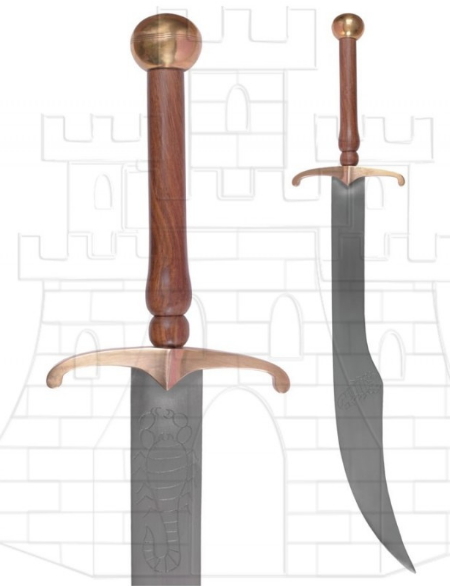
Forging: the secret of steel and the blade pattern
The most valued historical scimitars are usually made with techniques that today we associate with what is called “Damascus steel.” Although the terminology is broad and sometimes confusing, what is relevant is that these steels combined carbon and strategic forging to obtain resistant, hardened blades with an undulating visual pattern that we admire today.
In parallel, regions like Toledo developed their own metallurgical tradition that competed in quality. The knowledge of tempering and laminating was crucial: a blade that was too hard could break, and one that was too soft would not cut efficiently.
Use in combat and cavalry tactics
The scimitar excelled in light and medium cavalry tactics: rapid charges, skirmishes, and flank attacks. Riders practiced slashing blows in motion, taking advantage of the horse’s speed. A well-aimed blow could disarm or incapacitate without the need for a deep thrust.
In addition to individual technique, the scimitar coexisted with other weapons: spears, bows, and shields. Its main advantage was its versatility in mobile actions and its ease in inflicting continuous cuts that exhausted heavy infantry.
The scimitar in the Iberian Peninsula
During the Muslim presence in the peninsula, the image of the scimitar was consolidated as a symbol of Arab cavalry. Although the swords used in the initial campaigns in the peninsula were usually straighter and wider bladed, over time there was mutual influence: scimitars arriving as booty, gifts, or through technical exchanges were integrated into the local imagery.
In Spanish texts, the term “scimitar” clearly appears in the 16th century in fictional works and chronicles that reflect the Western perception of Muslim weapons. However, archaeological and artistic evidence shows that the material presence of curved sabers in the peninsula was more limited and concentrated in later centuries, when exchanges with the Eastern Mediterranean and the Maghreb were more intense.
Symbolism, status, and figures who wielded the scimitar
The scimitar was not just a weapon: it was an emblem of power. In the Ottoman Empire, the kilij became a symbol of military status. In Persia, the elegance of the shamshir was associated with nobility. Its semicircular silhouette was linked to the crescent moon, a symbol present in Islamic art.
Great historical figures appear in relation to this weapon: Saladin in the 12th century, Mehmed II in the Ottoman Empire, or Nader Shah in Persia. In literature and popular culture, the scimitar accompanies heroes and pirates like Sandokan or Sinbad the Sailor, fueling its legend.
How to identify a replica versus a historical piece
If you are interested in collecting or buying replicas, it is useful to know what to look for:
- Blade material: Modern steel or historical forging. A genuine Damascus steel or a true Toledo steel will have signs of artisanal forging and tempering.
- Handle and mounting: Well-worked brass, silver, or leather details usually indicate better quality.
- Patina and wear: Historical pieces show patinas that are difficult to honestly reproduce.
- Documentation: Provenance, tests, and metallographic studies are key for museum or auction pieces.
If you are looking to acquire a functional or decorative replica, it is best to check the seller’s reputation and ask for manufacturing details. For this, you can find models and replicas in our store, where various versions and qualities are shown.
Comparative table: key features by variant
| Variant | Curvature | Common Use | Typical Hilt |
|---|---|---|---|
| Shamshir (Persia) | Very curved | Light cavalry and duels | Straight handle, minimal guard |
| Kilij (Ottomans) | Pronounced curve with yalman | Charge and powerful cut | Hilt with protection and decoration |
| Talwar (India) | Moderate curve | Mixed combat, cutting and strength | Disc-shaped handle |
| Saif / Nimcha / Pulwar | Variable | Regional and naval | Local protections |
Scimitar Catalog and Selection
The scimitar today maintains an active presence in three main areas: historical and museological study, manufacturing by artisans, and private or reenactment collection. The most important museums preserve specimens for study and exhibition; modern artisans reinterpret ancient techniques to create functional and decorative replicas; and military history enthusiasts seek it for its beauty and technical value.
Common topics and myths
There are many popular ideas that should be nuanced: not all scimitars were made of “magic steel”; not all were ceremonial weapons; and their use varied according to the era and region. Their myth often comes from literature and the imaginary of the Crusades, which blended real data with stereotypes.
Presence in museums and popular culture
Historical examples of scimitars are preserved in museums such as the Victoria and Albert Museum, the Topkapi Palace, the Met, the British Museum, or the Louvre, among others. In popular culture, it appears in novels, comics, movies, and video games, where its silhouette is a visual shortcut to evoke the Orient and adventure.
Recommendations for those who want to start collecting
- Research: Understand the variants and ask for certification where possible.
- Quality over aesthetics: A well-forged replica is worth more than a flashy and weak ornament.
- Consult specialists: Blacksmiths, historians, and reputable dealers.
- Buy from reliable places: For replicas and modern pieces, the best option is to purchase from our store where the manufacturing and origin of each model are detailed.
The scimitar sword is, therefore, an object that combines functional design, metallurgical mastery, and a powerful symbolic value. Understanding its history and variants allows it to be appreciated beyond its visual charisma: it is a tool designed by and for mobile warfare that became a cultural emblem.
SEE MORE SCIMITAR SWORDS | SEE MORE ARABIAN SWORDS | VIEW OUR STORE
